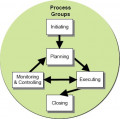Experience Engineering Project Overview

Abstract
This is an overview of a project outline for creating a training manual in regards to experience engineering in the call center. It has been designed for use with a five person team. Timelines have been explained and allow for staggered start and stops on various portions of the project. Both Gantt and PERT charts have been included to help explain the process and flow of the entire project, which covers a timeline of just over 100 days complete with multiple draft stages.
Introduction
The contact centers of today are a far cry from the call centers of yesterday. Today, representatives are expected to communicate with consumers by phone, email, instant chat messaging, and social media platforms. Even some of the simplest contact centers require a minimum of five or more systems in order to help customers. Representatives are expected to follow a variety of newer regulations that their parent companies are still trying to fully grasp including customer proprietary network information (CPNI), sensitive private information (SPI), the Sarbanes Oxley Act, and more. Still, with all of these new and more complex tools and systems, new hires are recruited from amongst high school educated young adults—often those with minimal experience and minimal skills, paid only slightly above minimum wage. Further, call centers are known to have high turnover rates, which industry leaders expect to get worse before they get better (International Customer Management Institute, 2008). The relative success or failure of a contact center revolves around their ability to provide the best possible customer service for their external customers while keeping costs to a minimum. One of the more recently evolved techniques in doing this is through the use of experience engineering. Experience engineering evolved from previous techniques such as social engineering and behavioral economics. Dixon and Toman (2010) talk about experience engineering going “well beyond traditional soft skills,” using “careful language choice to frame answers in the best possible way,” and being calculative and anticipatory rather than simply empathetic. Experience engineering is not a totally new concept. Rather, experience engineering is a new take on several older techniques. In an effort to help boost call center metrics within a specific company, the decision to develop an experience engineering training manual has been made. This will require the work of a relatively small team. As it is a new and unproven team and project lead within the company, the project must be run smoothly with minimal setbacks, delivering ahead of schedule and under budget would be a primary focus here. In the following few pages, a review of the project, its milestones, and overall guidelines will be presented.
Defining Important Parts of the Project
While it is quite possible for a project focused on putting together a call center training manual on experience engineering to lead into other projects even projects that are expansions of the initial—a manual going to a slideshow, to a video, to a web-based training applications, etc.—it is important to first properly define what the initial project covers. It is important to stay within that initial scope of work before looking toward any additional work. Without clearly defined tasks and roles, the project would be doomed from the beginning. There’s an old military adage that it would serve any project manager well to remember: “Proper precise planning prevents piss poor performance.” This is why we set our guidelines first, which will help us stay on task. Because this is a business project, it is important to work adhering to a schedule and a budget.
The goal of this project is to write a training manual on the basics of experience engineering. There will need to be research done on experience engineering. There will need to be an outline drawn up based on initial research, which will cover the main topics of experience engineering. From there, the document will need drafted and reviewed. It will also need graphics to help explain and keep interest within the training document. There will be a need for formatting the text and images as well. This is a team effort. There will need to be at least one writer, one graphic artist, and one editor. Through experience, I have learned that while a writer can edit their own work, it comes out much better if someone who did not write the words is the one editing it. One of these roles can also play the part of the project manager. To speed the work along and ensure that the project is a high quality, we will be working with a total of three writers, each of whom will also act as editors. We will have two individuals working with the graphics—one will acquire and edit the initial images, the second will review those images for flaws and improvement as well as place within the document and format that document. One of the writers will also serve as project manager.

Developing a Project Timeline
In creating a training manual for experience engineering within the call center environment, it has been determined that the team will consist of five employees. These employees are paid either hourly or salary. It is important to develop a timeline for this project for a variety of reasons. The time that employees put into the project has a financial cost associated with it. The salaried employees are paid based on their time as are the hourly employees. With a properly developed timeline, the project manager will be able to accurately measure progress throughout the different stages of the timeline, which will allow them to make adjustments and deliver reports along the way rather than getting to the suggested deadline and realizing only then that there are issues. “A predictive schedule is one of the most powerful tools a project manager has. It provides essential information on status, flags conflicts before they happen, and provides backup when requesting resources,” (McGraw, 2009).
The key components of this project include researching the topic, writing and editing the material, creating and inserting graphics, and properly formatting the document. It is easier to break this project down into its main components and understand that some tasks can overlap. One technique that will help manage the project’s timeline is the Gantt Chart, which provides a general description and graphical overview of the different parts’ timeline within the whole project. “This technique’s primary advantage is its good graphical overview that is easy to understand for nearly all project participants and stakeholders,” (Managing Project Risk, 2010). Below, there is a Gantt Chart, which covers the expected timeline for the experience engineering training manual project.
A Gantt Chart for Project Management
This chart shows the expected timelines for creating a basic outline (starting on day one and lasting five days), researching key topics (starting day one and lasting thirty days), writing the first draft (starting on day ten and lasting thirty days), the first edit and review (starting on day forty and lasting five days), initial graphics acquisition and creation (starting on day forty and lasting thirty days), writing the second draft (starting on day forty-five and lasting fifteen days), the second edit and review (starting on day sixty and lasting five days), the writing of a final draft (starting on day sixty-five and lasting twenty-five days), inserting the graphics into the document (starting on day seventy and lasting fifteen days), finalizing the document templates and formatting (starting on day seventy and lasting thirty days), a final edit and review (starting on day ninety and lasting ten days), and the publishing process (starting on day 100 and lasting five days).
This timeline was designed to allow work to be completed in tandem. Research and outlining can begin right away. Research can be done as the initial writing process begins, initial drafts covering topics in broad strokes while more research will allow for more refined drill downs of the material. The editing and review process are given a bit more time, because we are allowing each writer to individual review and propose edits over the first few days and then come together for two days to go over all errors and recommended changes. Most likely, the majority of these tasks would be completed early. It seems like a better idea to provide longer estimates, which will help with risk management with the project. The biggest issue here will be the timeline.

Project Evaluation & Review Technique and the Critical Path
In order to keep the project to create a contact center training manual on experience engineering, the PERT method makes the most sense. It allows for varied task resolution dates while helping maintain the overall flow of the project. The critical path concept allows us to make sure the most important tasks are completed on time, as other tasks rely upon those earlier tasks to be done. For example, in this case, the project would not be able to move on to the second draft if the first draft and subsequent review were incomplete.
SearchSoftwareQuality.com (2011) provides an excellent explanation in saying “a PERT chart is a project management tool used to schedule, organize, and coordinate tasks within a project.” They go on to explain that PERT is preferred over the Gantt in that it indicates task dependencies and helps to better illustrate the flow of the project scope. The downside, however, is that the PERT chart is more complex than the Gantt, so not as easy for everyone to understand as readily.
Above is an example of a PERT chart—one that would work with this project. I have also attached the image individually for easier viewing. Essentially, we have four independent tasks: research, writing, graphics, and formatting. The research is totally independent and can be done all on its own. Some basic research should be done before stepping toward writing, where the first task is creating an outline. The outline must be completed before writing can be done, and each draft must be reviewed and edited before moving on to the next draft. Graphics can be started on their own, but the initial draft at least should be available to help the graphic artists in determining how many images they will need and for stylistic matching. The formatting and templates is related to the images and it would be best to have the final draft done, so the team could verify a closer estimate for spacing and such.
By keeping an eye on the timeline from the Gantt chart and combining it with the interdependencies of the PERT chart, the project will be able to be managed more efficiently. The PERT chart also points out the critical paths, so we know what must be completed in order to move ahead with other parts of the project.
Project Risks
As mentioned previously, the largest risk factor for this project is time management. The only cost will be the time invested by employees already on payroll and possibly investing in some stock images. If the project goes past its estimated time of delivery, the budget is compromised. For that reason, the timeline was extended to allow for some delay. We also have a number of items that can be started earlier without being harmed by other parts of the project not being done.
The downside of this particular project is that it is being done in house by a specific team. There is no allowance for review and feedback from the people who will be using it. For this reason, the project is recommended as only an initial stage. User reviews can be completed as part of a second phase.
Communication is also paramount during this project. This is the reason each piece will be reviewed by no less than three individual parties. Final decisions will be made by the project manager. If one of the team members is having difficulty with an assigned task or falling behind, this needs to be communicated to the rest of the team, so something can be worked out. Tasks can be shared and moved around as necessary, but we need to know it is an issue sooner rather than later.
Conclusion
Overall, this is a relatively simple project. It has been designed with the intent of a multiple person team rolling out a new concept to the contact center and contact center management. The downsides are the lack of input from staff before putting the project together. Because the timeline was exaggerated, the group does have some wiggle room in completing tasks in a timely fashion. Because it is a small team, roles and tasks can be altered as necessary, and communication will be able to flow easier between only a few people and a single level of management rather than the slow and complex flow we would see with larger groups and more levels of management. With the Gantt and PERT charts, the group can measure their success on daily basis in regards to meeting goals, so there are no surprises down the road.
References
Dixon, M. & Toman, N. (2010). How call centers use behavioral economics to sway customers. Retrieved September 25, 2011 from http://webcache.googleusercontent.com/search?q=cache:C0cNqcG9LqQJ:blogs.hbr.org/cs/2010/07/how_call_centers_use_behaviora.html+call+center+customer+service+scripts+word+choice+research&cd=3&hl=en&ct=clnk&gl=us
International Customer Management Institute. (2008). Is now the time to focus on retention? The scope of turnover for 2008.. Retrieved September 25, 2011 from http://www.icmi.com/Resources/Articles/2008/December/Is-Now-the-Time-to-Focus-on-Retention-The-Scope-Of-Turnover-For-2008
McGraw, B. (2009). Why your project needs a predictive project schedule. Retrieved September 25, 2011 from http://fearnoproject.com/2009/02/13/why-your-project-needs-predictive-schedules/
SearchSoftwareWuality.com. (2011). PERT chart (program evaluation review technique). Retrieved September 25, 2011 from http://searchsoftwarequality.techtarget.com/definition/PERT-chart









